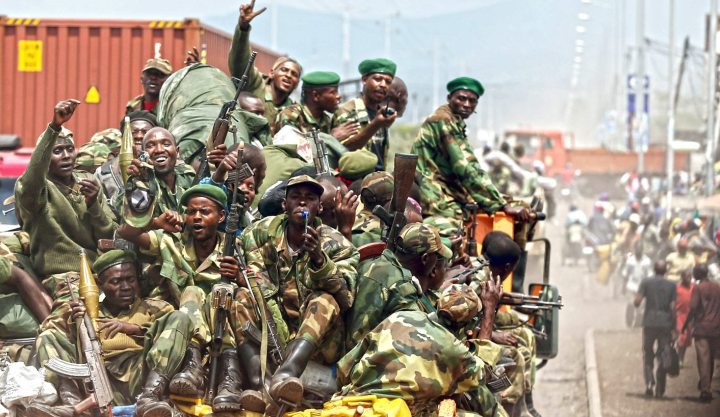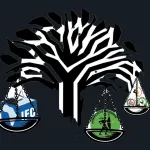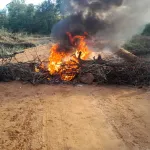Africa
DRC: The relevance of Human Rights Watch in a stubborn conflict

As the content of the Human Rights Watch annual report is absorbed in the coming days, the relevance of activist organisations like HRW to international politics is also under discussion. By KHADIJA PATEL.
Tiseke Kasambala, advocacy director of the Africa Division of Human Rights Watch (HRW) declines to pronounce on whether the last year saw the human rights situation in Africa improve or deteriorate.
“I can’t say if we are better or worse off,” she said at the launch of HRW’s annual world report in Johannesburg. “In certain circumstances things have worsened. We’ve seen another crisis coming up in Mali. At the same time you’ve seen improvements in Somalia. So you can’t say the situation is holistically worse or holistically better. It’s a mixed bag. And it’s quite often a mixed bag.”
Still, Kasambala stressed the positives. “Towards the end [of the Africa chapter in the report], I mention it is not all doom and gloom, [even though] we saw emerging crises in places like Mali, on going tensions between Sudan and South Sudan and on-going, long-standing crises in places like the Democratic Republic of Congo, Zimbabwe, Ethiopia, Eritrea,” she added.
Kasambala noted that Zimbabwe, Kenya, South Sudan, Mali and the Democratic Republic of Congo could prove to be hotspots of human rights abuses in the coming year. Juxtaposed against the existing legacy of human rights violations, the outlook for human rights on the African continent certainly does not appear too promising.
In the fog of conflict and the gloom of repressive regimes, the role of organisations like HRW in documenting the experiences of ordinary people has been crucial. In January last year HRW investigated Ethiopia’s “villagisation” programme, which was hailed by the government as a successful voluntary relocation project, but was labelled by HRW as a purposeful attempt to move farmers to accommodate foreign land investors.
Similarly, when the Kenyan army ventured into Somalia, lending a renewed vigour to the war against Al-Shabaab, HRW shed light on a crackdown in the North Eastern province of Kenya, intent on weeding out the Somali cell of al-Qaeda sympathisers. Kenyan Somalis and Somali refugees were arbitrarily arrested and gravely mistreated. And in the bluster of war, these violations could easily have been overlooked.
In Kenya and Ethiopia, as elsewhere, HRW is a filter between the official version of events and the reality on the ground. Their investigations sift through the verbose offerings of politicians, legalese and official policies to demonstrate the impediments to basic human rights. Their job is to reveal the reality lurking beneath the daily political spectacle. Their revelations are the end result of policymaking, politicking and war mongering. It is the living, breathing reality of it all. And through their revelations they are able to influence what comes next, how we react, and who says what to whom.
Their work is rightfully lauded.
Recently, however, the organisation’s stance in the conflict in the eastern DRC has been criticised for being too one-dimensional.
Writing in the New York-based Inner City Press, Matthew Russell Lee says, “HRW has historically been focused on Eastern Congo, particularly through now-deceased Alison des Forges. But of late, HRW director Ken Roth has only one line on the Congo: the M23 mutineers are bad; Rwanda supports them; so Rwanda is bad and should not be in the UN Security Council.
“It’s an advocacy line, but Human Rights Watch usually pretends to be objective, at least while it is collecting facts. This model would be: compile a multi-sided depiction of a zone of conflict, name the bad actors on all sides, and then advocate.”
Human Rights Watch was instrumental to revealing alleged links between Rwanda and the M23 armed group in eastern Congo last year.
These links between Rwanda and Uganda to the M23 militia cannot be undermined. Severing support for M23 will certainly go some way to quelling the conflict. At the same time, though, it does bear asking if our understanding of the conflict in the eastern Congo through essential intermediaries like Human Rights Watch is not nuanced enough.
Lee alleges that HRW has been particularly silent on human rights violations committed by the Congolese army. He points out that the United Nations admitted that the Congolese army was guilty of 126 rapes in Minova in late November last year. More says HRW has been reluctant to criticise anyone besides M23, in the process rendering the Congolese army above reproach.
He criticises the United Nation’s reticence in this regard as well, but his criticism of HRW stems from a sense that HRW ought to be more robust to ensure their reports are indeed an accurate portrayal of what is actually happening on the ground.
Kasambala, however, says HRW has sought to document human rights abuses by all sides of the conflict in the eastern Congo. As she put it, “ We have documented abuses by the Congolese itself, not just as they fled Goma but [also] in other parts of the country. I think we have confirmed that at least 80 women and girls were raped by the Congolese army [in late November].”
She insists that HRW is trying its utmost to give as full a picture of the eastern Congo as possible.
“We are trying to document abuses by all parties,” she said in her address. “There are also other militias committing abuses in other parts of the country, and the Congolese is one of them.”
The real significance of this can only be felt in the influence of all those working to bring some semblance of a peace plan to the eastern Congo. Later on Thursday, South Africa’s minister of International Relations and Co-Operation assured the media that the United Nations-backed peace plan for the eastern Congo had not been halted. (Just days ago, opposition from South Africa appeared to have scuppered the entire deal.) South Africa claimed SADEC had not been given enough time to pore over the contents of the proposed plan, but the plan was still on the table. It was just the final green light to the entire process that had been withheld.
As the minister explained the proposal to bolster the United Nations’ peacekeeping force in eastern Congo, the expectations and the optimism of it all, the significance of HRW’s work is particularly apparent. It is up to organisations like HRW to ascertain whether, in the name of bringing peace, the “inalienable fundamental rights to which people are inherently entitled simply because they are human beings” are being violated. DM
Read more:
- Human Rights Watch World Report 2013
Photo: M-23 rebel fighters are seen on a truck as they withdraw from Goma December 1, 2012. REUTERS/Goran Tomasevic
















